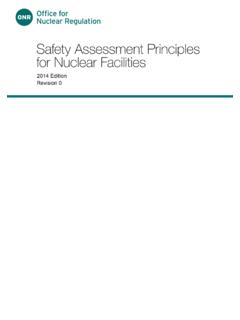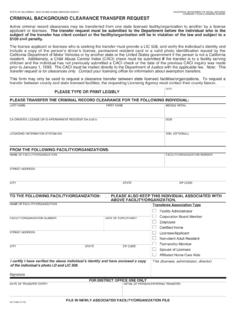Transcription of Licensing Nuclear Installations - Office for Nuclear ...
1 Office for Nuclear Regulationpage 1 of 80 Licensing Nuclear Installations4th edition: January 2015 Office for Nuclear Regulationpage 2 of 80 Licensing Nuclear Installations 4th edition January 2015 This guide provides an overview of the Nuclear regulatory regime and the processes for Licensing and delicensing Nuclear sites. It is published on the Office for Nuclear Regulation s website at for Nuclear Regulationpage 3 of 80 Licensing Nuclear Installations 4th edition January 2015paragraph Section 1: The law and the regulatory regimeThe Health and Safety at Work etc Act1 Reducing risk and the ALARP principle 2 The Energy Act 2013 3 5 The Nuclear Installations Act 19658 The Nuclear site licence9 13 Licensable activities (prescribed activities)14 15 Licence conditions16 18 Operational methods19 28 Assessment21 22 The safety case23 24 Inspection25 28 Regulatory controls29 32 Appeals33 Regulatory costs34 35 Other legislation relevant to the safety of Nuclear sites36 38 Security39 40 Transport41 46 Environment47 49 Regulation of sites operated on behalf of the Nuclear Decommissioning Authority50 Regulation of defence related Nuclear sites51 53 International obligations54 58 Western European Nuclear Regulators Association59 Section 2.
2 The Licensing process New Nuclear sitesBackground60 61 Pre application advice62 Site selection63 66 Site suitability65 66 New Nuclear power stations and generic design assessment67 69 Design acceptance period of validity69 The point of licensing70 72 Early licensing70 71 Latest point of licensing72 The Licensing process, including table: Licensing new Nuclear sites Step by step Licensing process 73 Step 1 Preparing to be a licensable organisation74 94 Applicant organisation status75 78 Dual and joint licensing79 80 Leadership: Duties of directors81 83 Relationship between a parent company and a licensed subsidiary84 Organisational capability85 89 Core capability90 92 ContentsOffice for Nuclear Regulationpage 4 of 80 Licensing Nuclear Installations 4th edition January 2015paragraph Developing licence condition compliance arrangements93 94 Step 2 Collation of licence application dossier95 97 Step 3 Licence application98 100 Step 4A Assessment of the application101 119 Assessment of the safety case submissions102 104 Assessment of the licence applicant s organisational capability105 Assessment of the site106 Defining the site boundary107 Security of tenure108 Assessment of licence condition compliance arrangements109 Decommissioning strategies.
3 Plans and programmes110 Waste management and disposal111 114 Assessment of emergency preparedness and response115 116 Assessment of security requirements117 118 Safeguards119 Step 4B Consultation120 130 Mandatory consultation with the environment agencies120 Public body notification121 124 Approved funded decommissioning programme125 Nuclear liability insurance126 127 Justification128 129 Financial standing130 Step 5 Granting the licence131 133 Step 6A Regulation under the licence Installation134 141 Step 6B Regulation under the licence Commissioning142 148 Step 6C Regulation under the licence Operation149 Section 3: RelicensingNeed for relicensing150 151 Proportionality152 154 Relicensing for a change of operator155 158 Relicensing for new activities159 162 Relicensing to bring additional land within the licensed site boundary163 166 Section 4: DelicensingDelicensing and ending the licensee s period of responsibility167 168 The legal basis for ending the licensee s period of responsibility169 173 Overview169 Delicensing the whole site170 Partial delicensing171 Partial delicensing via relicensing172 173 Interpretation of no danger 174 175 Delicensing the whole site Methodology of inspection and assessment176 179 Consultation178 179 Partial delicensing180 184 Retention of records185 Annexes1 Regulatory powers available to ONR2 The role and duties of the Nuclear Decommissioning Authority3 The site boundary and map ReferencesOffice for Nuclear Regulationpage 5 of 80 Licensing Nuclear Installations 4th edition January 2015 ALARP As low as reasonably practicable AWE Atomic Weapons Establishment CDG 2009 The Carriage of Dangerous Goods and Use of Transportable Pressure Equipment Regulations 2009 (as amended)
4 CNS Civil Nuclear Security COMAH Control of Major Accident Hazards Regulations 1999 DAC Design Acceptance Confirmation DECC Department for Energy and Climate Change DSEAR Dangerous Substances and Explosive Atmospheres Regulations 2002 EA The Environment Agency EA13 The Energy Act 2013 EIADR Environmental Impact Assessment Decommissioning Regulations EU European Union Euratom The European Atomic Energy Community FDP Funded Decommissioning Programme GDA Generic Design Assessment GDF Geological Disposal Facility HSE Health and Safety Executive HSW Act Health and Safety at Work etc Act 1974 IAEA United Nations International Atomic Energy Agency LC Licence Condition MCA Maritime and Coastguard Agency MHSW Management of Health and Safety at Work Regulations 1999 MoD Ministry of Defence NDA Nuclear Decommissioning Authority NEPDC Nuclear Emergency Planning Delivery CommitteeList of abbreviationsOffice for Nuclear Regulationpage 6 of 80 Licensing Nuclear Installations 4th edition January 2015 NEPLG Nuclear Emergency Planning Liaison Group NIA65 The Nuclear Installations Act 1965 NISR Nuclear Industries Security Regulations 2003 NSL Nuclear Site Licence NORMS National Objectives, Requirements and Model Standards OECD Organisation for Economic Co-operation and Development ONR Office for Nuclear Regulation PBO Parent body organisation PCmSR Pre-commissioning safety report PCSR Pre-construction safety report POSR Pre-operational safety report ( installation safety report) R2P2 Reducing risks, protecting people REPPIR Radiation (Emergency Preparedness and Public Information)
5 Regulations 2001 RMT Radioactive Materials Transport Team RWMD Radioactive Waste Management Directorate SAPs Safety Assessment Principles for Nuclear Facilities SEPA The Scottish Environment Protection Agency SLC Site licence company SMP Safety management prospectus SoS Secretary of State TAGs Technical Assessment Guides WENRA Western European Nuclear Regulators AssociationOffice for Nuclear Regulationpage 7 of 80 Licensing Nuclear Installations 4th edition January 2015 ForewordChief Executive s ForewordThe Office for Nuclear Regulation (ONR) is Great Britain s principal independent regulator for Nuclear safety and security. We are committed to ensuring that the Nuclear industry controls its hazards effectively, has a culture of continual improvement and sustains excellence across the Nuclear estate. It is our duty to ensure that our processes and our regulatory judgements are open, transparent and robust. I believe that this is the only way to secure public trust and confidence in ONR as an effective regulator and I am delighted that ONR is now established as a Public Nuclear Installations sets out how and why we license sites that carry out prescribed activities.
6 It covers the entire facility life cycle, from the Licensing of new sites through the relicensing of existing sites to the final delicensing of sites where facilities have been decommissioned and there is no danger to the public. change activities to facilities. As such, it describes how we deliver our mission of providing efficient and effective regulation of the Nuclear industry, holding it to account on behalf of the public and is therefore an important and fundamental part of our regulatory trust that this guidance will be of interest and value to organisations considering applying for a Nuclear site licence as well as the public and other stakeholders who will be able to read about the rigorous process of review, assessment and challenge which ONR conducts as part of the Licensing JenkinsChief Executive Officer, Office for Nuclear for Nuclear Regulationpage 8 of 80 Licensing Nuclear Installations 4th edition January 2015 Chief Nuclear Inspector s ForewordLicensing Nuclear Installations provides guidance on the Licensing process and the factors that ONR may take into account when reviewing a licence application.
7 ONR is committed to being an effective regulator, and we seek to ensure that our processes and practices remain transparent and current. We have therefore revised this document to reflect recent legal changes arising from implementation of the Energy Act 2013 (EA13)A prospective licensee should be aware that the granting of a Nuclear site licence is a significant step but is not itself permission to start Nuclear -related construction. That requires a regulatory permission under a licence condition, which is based on a substantial pre-construction safety case showing that the associated risks and hazards have been assessed, appropriate limits and conditions have been defined and adequate safety measures have been identified and put in place such that the facility can be operated safely. But before a licence is granted, ONR needs to be satisfied that the applicant s choice of site is suitable, that it understands the hazards and risks of the activities that it proposes to carry out, and that it has a suitable schedule of safety submissions leading through to the pre-construction safety case.
8 We also emphasise the need to gain confidence that the applicant has the organisational capability to lead and manage for safety effectively. This means that we must be satisfied with the applicant s governance arrangements, resources, competencies and management processes before we will consider granting a of Nuclear sites have an obligation to protect their workforce and the public from risk so far as is reasonably practicable. The Licensing process is an important stage in confirming that they are ready and able to meet these obligations, and in so doing provides assurance to employees, local communities and the wider public. It also, importantly, provides stringent tools and powers which enable ONR to ensure that future operations are supported by adequate safety cases and are subject to appropriate regulatory permission and HallChief Nuclear InspectorOffice for Nuclear RegulationOffice for Nuclear Regulationpage 9 of 80 Licensing Nuclear Installations 4th edition January 2015 The safety of Nuclear Installations in Great Britain (GB) is assured by a system of regulatory control based on a Licensing process by which a corporate body is granted a licence to use a defined site for specified activities.
9 This document describes how the ONR regulates the design, construction and operation of any Nuclear installation in GB for which a Nuclear site licence is required under the Nuclear Installations Act 1965 (NIA65). Such Installations include Nuclear power stations, Nuclear fuel manufacturing facilities, Nuclear defence facilities for weapons manufacturing and fuelling/maintenance of Nuclear submarines, reprocessing facilities and facilities for the storage of bulk quantities of radioactive matter which has been produced or irradiated in the course of the production or use of Nuclear was established by the Energy Act 2013 (EA13). ONR s principal function is to take such action as it considers appropriate for the purposes for which it was established. These purposes relate to Nuclear safety; conventional health and safety on Nuclear sites; Nuclear security; Nuclear safeguards and the transport of radioactive materials. The activities that ONR carries out include proposing new law and standards, assessing and inspecting to judge compliance and encourage adoption of good practice, enforcing legislation, investigating work-related accidents and incidents, conducting research, and providing information, guidance and advice on matters relevant to its purposes.
10 ONR reports to the Secretary of State for Work and Pensions, though it may report on specific matters to other Secretaries of State as appropriate. ONR is the Licensing authority for Nuclear Installations in GB and advises the Secretary of State for Energy and Climate Change and the Secretary of State for Defence on Nuclear s mission is to provide efficient and effective regulation of the Nuclear industry, holding it to account on behalf of the public. ONR brings together the regulatory functions for Nuclear safety, Nuclear security, Nuclear safeguards, radioactive materials transport and conventional health and safety at Nuclear for Nuclear Regulationpage 10 of 80 Licensing Nuclear Installations 4th edition January 2015 Office for Nuclear Regulationpage 11 of 80 Licensing Nuclear Installations 4th edition January 2015 The Health and Safety at Work etc Act 1974 1 Operators of Nuclear facilities in Great Britain, like their counterparts in other industries and places of work in general, are required to comply with the HSW Act and its relevant statutory provisionsa.














